The best of Argentina’s far-flung vineyard regions are united by their differences, as Andrew Catchpole explains.
From the beaches of the Atlantic coast to the dizzyingly high Andean altiplano, by way of regions as diverse as the Pampas and Patagonia, Argentina folds in an incredible variety of landscapes along its 2,295 mile length. Think of the difference in habitats that are home, variously, to condors, cattle or penguins, and this gives a vivid idea of how the mix of terrain, climate and altitude changes as you travel about the eighth largest country in the world.
Argentina’s vineyards may not reach into the very farthest corners of the country. But they do a pretty good job in terms of making the most of the best growing areas, with producing regions stretching some 1,000 miles from the Patagonian plain in the south to northern Salta near the high border with Bolivia. And while most of the vines are secreted away to the west of the country, with most in oasis valleys following the foothills of the Andes, they still cover an incredibly diverse range of sites.
What they all typically have in common is a mix of dry, sun-bathed and healthy growing seasons, with warm days and cool nights delivering a purity of aroma and fruit quality in the final wines. Each, though, offers a distinct character of its own, favouring a slightly different mix of varieties, typically reflecting the culture and terroir of the region. Here we take a snapshot of three of the best.
Salta & The North
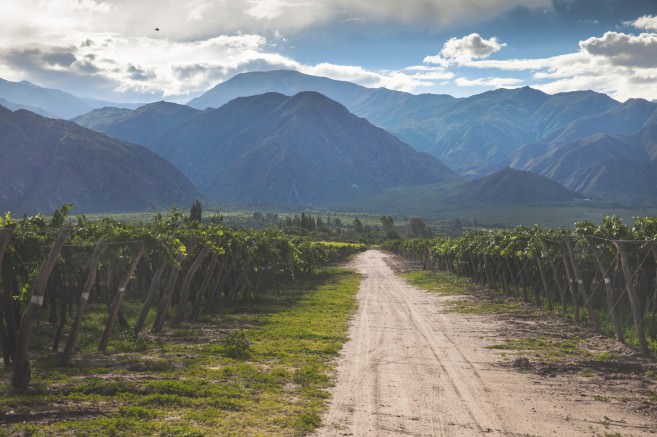
‘Vino Country’ Cafayate, Salta, Argentina; photo by Chris Ford.
On the Ground
With vines spreading from 4,200 to an incredible 9,860 feet above sea level, Salta’s main growing region of Cafayate (along with Catamarca and Tucumán) lies among stunning mountainous scenery as the land rises to the Andean Cordilerra.
Local Gastronomy
The Andean influence is strong here, with indigenous corn, beans and squash blending in with Spanish influences stretching back to the conquistadors, seen in foods such as the spicy or sweet empanadas and tamales, along with much beef and pork barbecued in the typical Argentine style.
A Night Out
Nicknamed Salta la Linda (Salta the Beautiful) because of its colonial architecture, coupled with a 3,700 foot high setting, Salta city offers an evocative mix of indigenous Andean and Spanish-influenced culture, with its museums and restaurants and nearby vineyards supporting a lively tourist trade.
The Wines
The climate here is perfect for Salta’s signature grape, namely Torrontés, a dry and incredibly aromatic, slightly spicy white. Cabernet Sauvignon and Malbec also flourish, with a similar intensity to the wines.
Mendoza
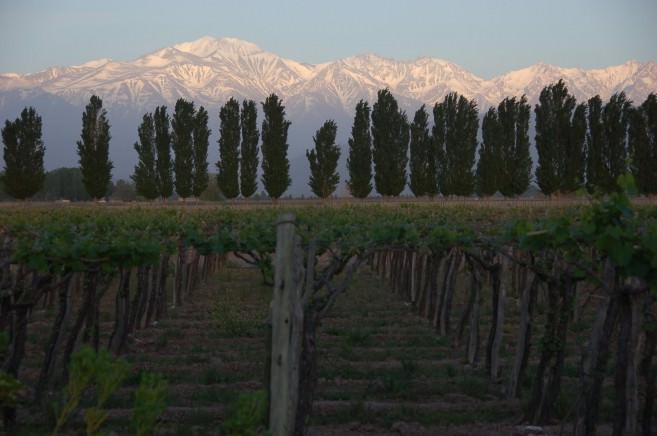
Sunrise in Mendoza; photo by Tony Bailey.
On the Ground
Wherever you stand in Mendoza province the Andes are an ever-present snowcapped backdrop, proving a scenic reminder of why this dry, high vine-growing area, irrigated by melted mountain water and warmed by intense sun, is Argentina’s premier wine producing area.
Local Gastronomy
Dubbed ‘The Napa of the South’, gastronomic options in Mendoza range from fancy molecular cuisine to the simplicity of goat and fantastic locally grown Mediterranean-type vegetables, plus much in between. But it is without question the full-on beef fest of the carnivorous asado that still best evokes the rugged spirit of this land.
A Night Out
One of the nine ‘Great Capitals of Wine’ worldwide, Mendoza town is a charming rural-paced oasis mixing up an attractive blend of good restaurants and bars with wine-focused tourism, along with providing a base for those aiming at more high octane, active and off-piste Andean adventures.
The Wines
As South America’s largest wine producing region, Mendoza is in fact several sub-regions, where Malbecs – ranging from rich, fruit-driven styles to more intense, aromatic higher altitude styles – vie with a host of varieties including fantastic Cabernet Sauvignon, spicy Syrahs, smooth Pinot Noirs, complex Chardonnays, crisp Sauvignon Blancs, aromatic Torrontes, emerging Spanish and Italian varieties, plus much else besides.
Patagonia
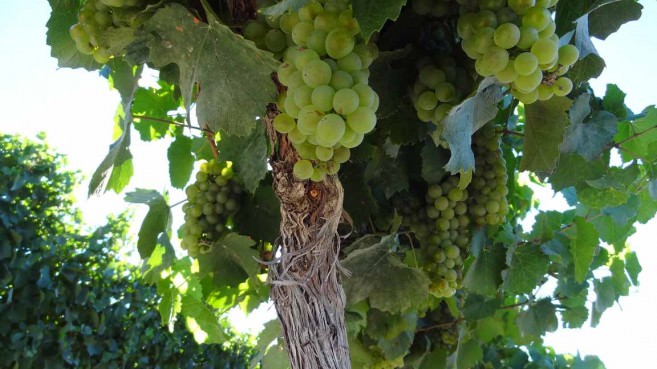
Grapes on vineyard near Neuquén, Patagonia; photo by Darren and Sandy Van Soye.
On the Ground
What Patagonia lacks in altitude it makes up for in terms of its cool climate, with the best wines produced in the green corridor along the Río Negro and in nearby Neuquén in this otherwise wind-swept southern plain with its cold winters and cool summer nights allowing a long, slow ripening of the grapes.
Local Gastronomy
Lamb takes over from beef here in the deep south as the meat of choice, with wild boar (introduced by Europeans) also appearing on the menu. Seafood and fresh water fish such as trout and salmon, from Patagonia’s abundant lakes and rivers, are also firm favourites.
A Night Out
Calm, quiet Neuquén is a pleasant outpost from which to visit the wineries of the region, also boasting an unusual wealth of paleontological sites where the bones of innumerable dinosaurs have been particularly well preserved.
The Wines
Malbec takes on a vivid, aromatic character here, while varieties as diverse as Pinot Noir and Semillon do particularly well, with the former being among Argentina’s most compelling examples of this entrancing Burgundian variety.


Latest posts by Andrew Catchpole (see all)
- Taste the Diversity: A Guide to Argentina’s Wine Regions - October 22, 2014
- The Global March of Malbec - October 1, 2014
- ‘Take 5’ Global Sommeliers: Argentine Food & Wine Pairings - April 16, 2014

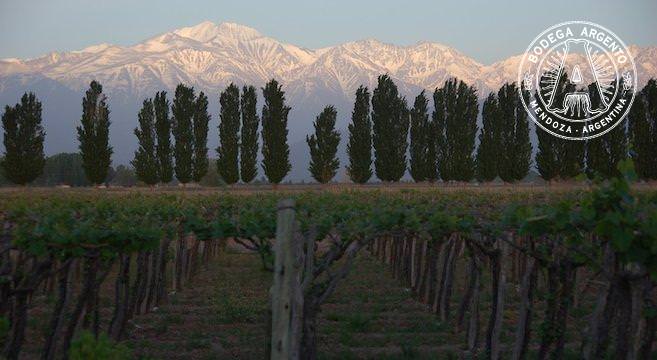
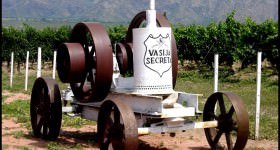 A Taste of Terroir: Argentina’s Diverse Wines & Wine Regions
A Taste of Terroir: Argentina’s Diverse Wines & Wine Regions  Argentina Wine Regions: Patagonia
Argentina Wine Regions: Patagonia 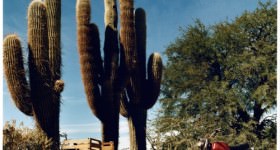 Argentina Wine Regions: Salta
Argentina Wine Regions: Salta 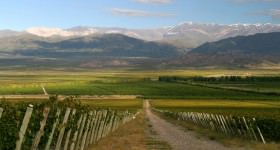 Argentina Wine Regions: San Juan
Argentina Wine Regions: San Juan 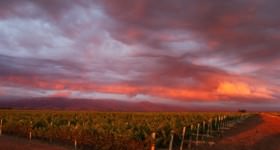 Argentina Wine Regions: Mendoza
Argentina Wine Regions: Mendoza 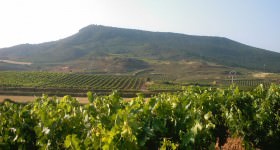 Know La Rioja, the famous wine region of Argentina
Know La Rioja, the famous wine region of Argentina 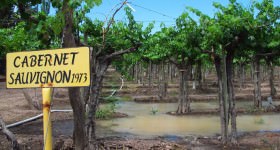 Cabernet Sauvignon – Argentina’s Next Big Red
Cabernet Sauvignon – Argentina’s Next Big Red  Lesser Known Argentina Wine Regions: Catamarca
Lesser Known Argentina Wine Regions: Catamarca 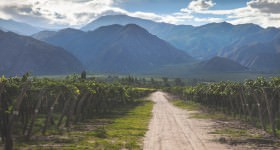 Grape Expectations: Less Common Varieties of Argentina Wine
Grape Expectations: Less Common Varieties of Argentina Wine 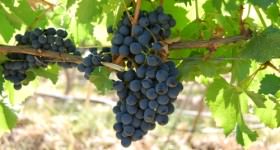 Argentinian Malbec – A Guide to the Grape’s History and Unique Style
Argentinian Malbec – A Guide to the Grape’s History and Unique Style 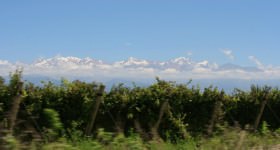 Top 10 Curious Facts About Argentina Wine
Top 10 Curious Facts About Argentina Wine 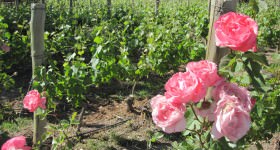 The New Wave of Wine from Argentina
The New Wave of Wine from Argentina
I love Cafayate. My favorite wine region.
[…] Taste the Diversity: A Guide to Argentina's Wine Regions … https://therealargentina.com/Think of the difference in habitats that are home, variously, to condors, cattle or penguins, and this gives a vivid idea of how the mix of terrain, climate and altitude changes as you travel about the eighth largest country in the … […]